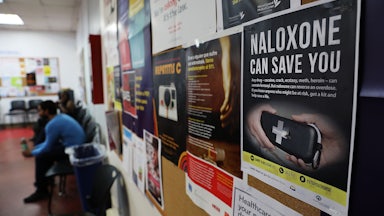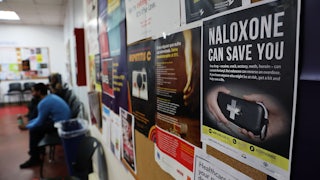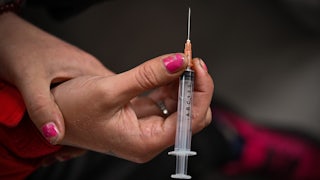As constant fearmongering about Cuba clearly hasn’t satiated Marco Rubio’s cynical drive to dust off passé political panics, he’s now moved on to crack, teaming up with Build Back Better–killing Democrat Joe Manchin to build back to the 1980s. After The Washington Free Beacon framed a months-old harm-reduction provision from the Cares Act as a measure to “fund crack pipe distribution,” the Florida senator swiftly introduced the Cutting Off Rapid Access to Crack Kits Act to ban federal cash from being used for the purpose. He and Manchin then collaborated on the Preventing Illicit Paraphernalia for Exchange Systems Act, to prevent similar arrangements for syringes and needles. The CRACK Act and the PIPES Act—get it? If the acronyms are any guide, Manchin, Rubio, and their bills’ various co-sponsors have found genuine delight in wringing every last drop of possible cachet from one of the more racist episodes of the “war on drugs.”
Dismayingly, Democrats seem more than happy to enable their aims. Far from vociferously defending an entirely defensible and evidence-based policy, they immediately surrendered to right-wing clickbait. Biden’s health and human services secretary and his White House drug policy adviser rushed into damage-control mode, issuing a joint statement insisting that “no federal funding will be used directly or through subsequent reimbursement of grantees to put pipes in safe smoking kits.” These proclamations were soon echoed by White House press secretary Jen Psaki, who emphasized, “We don’t support federal funding, indirect or direct, for pipes.” Liberal reporters backed them up, largely aghast at the “misinformation” lobbed by the Free Beacon and its aggregating copycats: “The BIDEN HANDS OUT CRACK PIPES thing was the dominant story across Fox News’s primetime programming on Tuesday, and spun as a sign of America’s moral decay,” as Aaron Rupar put it on Twitter. “But here’s the thing—it’s total BS!”
The actual B.S. is that one political party has suddenly started using a landmark public health strategy as disingenuous culture-war fodder, and its opposition has tacitly endorsed those tactics by pinky-swearing that the federal government would never distribute pipes, as if to imply that outrage over doing so would be appropriate. It isn’t: Harm reduction, including the provision of free glass pipes, deserves a wholehearted defense. The right’s opportunistic smearing of a risk-mitigation framework long championed by activists poses a serious threat to vulnerable populations, and it’s not an exaggeration to suggest that people could die as a result.
The toxic corner of the American psyche that the “BIDEN LOVES CRACK PIPES” hysterics are giddily tapping into has been forged by decades of bad policy. The cultural context surrounding the so-called war on drugs not only stigmatized substance use and filled up jails and prisons, but did its damnedest to make being “soft” on drugs and crime untenable. Black people bore the brunt of this, particularly with regard to crack: The drug was criminalized far more severely than cocaine, and Black people struggling with crack addiction were treated with contempt.
The maddest moment of the Crack Panic Era came in 1989, when Drug Enforcement Administration agents lured a dealer to Lafayette Park in Washington, D.C., to set up a drug buy so that then-President George H.W. Bush could hold up a bag of crack, obtained “across the street from the White House,” as a prop for his first prime-time televised speech to the nation. But however performative elected officials got with the “public safety” narrative undergirding the “tough on crime” era and its aftermath, the results wrought from all this posturing, overpolicing, and swollen prison populations were never well suited for addressing the impact of drugs. The mainstream has slowly accepted this reality in recent years, this week’s meltdown notwithstanding.
For years, advocates have struggled to overhaul society’s response to drug use, replacing the “war on drugs” framework with a harm-reduction one. Their case is both empathetic and logical. Using drugs is not a moral failure, but it can be a risk factor for illness and death: Over 100,000 people in the United States died of an opioid overdose last year. Many more drug users are at serious risk of life-threatening health problems: One study showed that up to 40 percent of drug users admitted to hospitals have bacterial or fungal infections. Intravenous drug use accounts for some 7 percent of new HIV infections each year, and up to 75 percent of people who use drugs have been exposed to hepatitis C, which as recently as 2014 was the deadliest infectious disease in the country. (Full disclosure: I do communications work for Treatment Action Group, a policy think tank focused on HIV, tuberculosis, and hepatitis C.)
The HHS grants caricatured as “$30 million for crack pipes” will allow community groups to distribute supplies—including overdose reversal medication, clean syringes, and balm to avoid cracked and bleeding lips—that reduce the harms of drug use in various ways. Contrary to the denials of liberals, unused glass pipes are another key harm-reduction tool: Glass is less likely than other materials to blister and burn the mouth, thus reducing the likelihood of infection; it’s safer not to share pipes (sharing has been linked to transmission of both T.B. and hepatitis C) and to smoke drugs instead of injecting them. (Meaning that pipes are used for many drugs, but singling out crack specifically—and remaining mum about syringes—is an awfully obvious racist dog-whistle.) That Democrats foreclosed on the possibility of funding sterile pipes for people who need them, as a capitulation to the sensibilities of whomever the CRACK Act panders to, is an act of sheer cowardice.
Harm reduction isn’t some hypothetical thought experiment on which we’re rolling the dice. Its track record makes it one of the most successful public health shifts of the past several decades. Studies in both the U.K. and Canada have shown that people often switch from injecting drugs to smoking them when provided with safe supplies. Needle-exchange programs have reduced rates of HIV transmission by up to two-fifths; one program in New York alone estimated that 87 potential infections were averted. By the early 2000s, one review had already identified 28 different studies concluding that clean syringe distribution decreased HIV transmission. A study in Washington showed that safer drug supplies curbed hepatitis infections by 60 percent. Safer smoking kits have also been demonstrated to reduce risky behaviors and infections. Safer smoking kits in Canada were correlated with a significant decline in hepatitis C, and the program was considered so effective that glass pipes have been included in vending machines. The vast majority of harm-reduction programming also offers health services for blood-borne and sexually transmitted infections. If I spent hours on this paragraph hyperlinking more and more studies recommending harm-reduction practices, I still wouldn’t run out of available material proving their unalloyed value.
The evidence that harm reduction and facilitating safer drug use saves lives is overwhelming. To return to the status quo of the late 1980s in the face of all this progress is absolute madness, as is the idea that an archconservative outrage cycle, based on obsolete notions with about as much currency as the Confederate Greyback, could roll back these programs just as they’re gaining long-overdue, and hard-won, mainstream acceptance is dismaying. That the Biden administration won’t stand wholeheartedly behind these community grants is equally enraging. The only problem, in fact, with the $30 million that had been previously allocated to these proven harm-reduction programs is that we should be spending even more.










